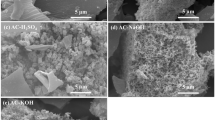Abstract
To prepare an efficient supercapacitor, an activated carbon from agave wastes was prepared and their electrochemical performance was evaluated as a novel electrode for supercapacitor. The carbon was prepared by two thermal pyrolysis processes under nitrogen atmosphere. The first pyrolysis was achieved at 500 °C until the charring of the bagasse; in the second pyrolysis step, the char was impregnated with different mass ratios of KOH (1:2–1:4) and thermally treated at 800 or 900 °C, for 1 h under N2 flow. The textural analysis showed that the activated carbon had a specific surface area of 1462 m2 g−1 and depicted a type I isotherm (IUPAC) characteristic of a microporous carbon. Raman spectroscopy and XRD measurements confirm that the activated carbon contains a small graphitization degree and a disordered structure. The electrochemical study of the symmetric carbon supercapacitor was carried out in 1 M Li2SO4 solution as the electrolyte. The electrochemical performance of the coin cell supercapacitor was evaluated under an accelerated aging floating test consisting of potentiostatic steps at different voltages (1.5, 1.6 and 1.8 V) for 10 h followed by galvanostatic charge/discharge sequences, and the overall procedure summarized a floating time up to 200 h. The highest capacitance was observed at a floating voltage of 1.5 V, with a large initial specific capacitance of 297 F g−1.








Similar content being viewed by others
Data availability
The research group does not present any problems with the disposal of data and material.
References
C. Nieto-Delgado, M. Terrones, J. Rangel-Méndez, Biomass Bioenerg. 35(1), 103–112 (2011)
B.E. Conway, Electrochem. Soc. 138, 1539 (1991)
P. Kleszyk, P. Ratajczak, P. Skowron, J. Jagiello, Q. Abbas, E. Frąckowiak, F. Béguin, Carbon 81, 148–157 (2015)
D. Salinas-Torres, S. Shiraishi, E. Morallón, D. Cazorla-Amorós, Carbon 82, 205–213 (2015)
S. Vaquero, J. Palma, M. Anderson, R. Marcilla, J. Electrochem. Soc. 160(11), A2064–A2069 (2013)
P. Kalyani, A. Anitha, Int. J. Hydrog. Ener 38(10), 4034–4045 (2013)
D. Weingarth, A. Foelske-Schmitz, R. Kötz, J. Power Sour. 225, 84–88 (2013)
E. Schröder, K. Thomauske, B. Oechsler, S. Herberger, Biomass Bioenergy, 333–356 (2011)
J. Chae, G. Chen, Electrochim. Acta 86, 248–254 (2012)
P. Przygocki, Q. Abbas, F. Béguin, Electrochim. Acta. 269, 640–648 (2018)
J. Ortiz-Bustos, S. Real, M. Cruz, J. Santos-Peña, Microporous Mesoporous Mater. 242, 221–230 (2017)
A. Bello, F. Barzegar, M. Madito, D. Momodu, A. Khaleed, A. Masikhwa, N. Manyala, Electrochim. Acta. 213, 107–114 (2016)
A. Abioye, F. Ani, Renew. Sustain. Energy Rev. 52, 1282–1293 (2015)
A. Laheäär, P. Przygocki, Q. Abbas, F. Béguin, Electrochem. Commun. 60, 21–25 (2015)
X. Li, W. Xing, S. Zhuo, J. Zhou, F. Li, S. Qiao, G. Lu, Biores. Technol. 102(2), 1118–1123 (2011)
V. Obreja, Phys E 40(7), 2596–2605 (2008)
G. Qiang, Ph.D. Thesis. Université d´Orléans (2013)
S. Moganty, R. Baltus, D. Roy, Chem. Phys. Lett. 483(1–3), 90–94 (2009)
X. Gao, W. Xing, J. Zhou, G. Wang, S. Zhuo, Z. Liu, Z. Yan, Electrochim. Acta 133, 459–466 (2014)
L. Timperman, H. Galiano, D. Lemordant, M. Anouti, Electrochem. Commun. 13(10), 1112–1115 (2011)
M. Galiński, A. Lewandowski, I. Stępniak, Electrochim. Acta 51(26), 5567–5580 (2006)
N. Shimodaira, A. Masui, J. Appl. Phys. 92(2), 902–909 (2002)
H. Wang, H. Chung, W. Liu, IEEE Trans. Power Electron. 29(3), 1163–1175 (2013)
M. Thommes, K. Kaneko, A. Neimark, J. Olivier, F. Rodriguez-Reinoso, J. Rouquerol, K. Sing, Pure Appl. Chem. 87(9–10), 1051–1069 (2015)
D. Momodu, M. Madito, F. Barzegar, A. Bello, A. Khaleed, O. Olaniyan, N. Manyala, J. Solid State Electrochem. 21(3), 859–872 (2017)
H. Ohno, Electrochemical ionic liquids (2005)
A. Elmouwahidi, Z. Zapata-Benabithe, F. Carrasco-Marín, C. Moreno-Castilla, Bioresour. Technol. 111, 185–190 (2012)
M. Lazzari, F. Soavi, M. Mastragostino, J. Power Sour. 178(1), 490–496 (2008)
H. Ibrahim, A. Ilinca, J. Perron, Renew. Sustain. Energy Rev. 12(5), 1221–1250 (2008)
A. Jain, R. Balasubramanian, M. Srinivasan, Chem. Eng. J. 283, 789–805 (2016)
Acknowledgements
Authors would like to thank CONACYT (Consejo Nacional de Ciencia y Tecnología) and PAICYT-UANL (Programa de Apoyo para la Investigación Científica de la Universidad Autónoma de Nuevo León) for the financial research support to this project. IKRH would like to thank CONACYT for PhD scholarship grant.
Funding
Consejo Nacional de Ciencia y Tecnología (CONACYT) and Programa de Apoyo a la Investigación Científica y Tecnológica, Universidad Autónoma de Nuevo León (PAICYT-UANL).
Author information
Authors and Affiliations
Contributions
IkRH: Formal Analysis, Research, Writing—Original draft, and Writing—Review & Editing. LCTG: Conceptualization, Methodology, Writing—Review & Editing, Validation, Supervision, Project Administration, Funding Acquisition, and Resources. EMSC: Methodology, Validation, and Writing—Review & Editing. LLGT: Conceptualization, Methodology, and Validation & Writing.
Corresponding author
Ethics declarations
Conflict of interest
The authors declare that they have no known competing financial interests or personal relationships that could have appeared to influence the work reported in this paper.
Consent to participate
Consent is approved by the research group.
Consent for publication
Consent is approved by the research group.
Ethics approval
Approved.
Additional information
Publisher's Note
Springer Nature remains neutral with regard to jurisdictional claims in published maps and institutional affiliations.
Rights and permissions
About this article
Cite this article
Keyla, RH.I., Leticia, GT.L., Maximiano, SC.E. et al. Activated carbon from agave wastes (agave tequilana) for supercapacitors via potentiostatic floating test. J Mater Sci: Mater Electron 32, 21432–21440 (2021). https://doi.org/10.1007/s10854-021-06649-0
Received:
Accepted:
Published:
Issue Date:
DOI: https://doi.org/10.1007/s10854-021-06649-0




